Bde Maka Ska- The Name Restoration of Minneapolis’ Largest Lake
By Kirsten Fedorowicz, April 2020
Bde Maka Ska (pronounced beh-DAY mah-KAH skah) is the largest and most visited lake in Minneapolis, a city that proudly calls itself “the city of lakes.” When I wasn’t social distancing, I would run around part of the lake, dodging many families, hot millennial couples, and fellow joggers.
The vestiges of the lake’s other name are still visible; not at the lake itself, but in the surrounding neighborhoods. On my run, I pass many small businesses who still carry it on their signs Lake Calhoun Grooming or Lake Calhoun Framing*. My aunt has lived in this city for the better part of thirty years and Lake Calhoun still slips off her tongue. It feels weird, to correct her; this is still more her city than mine. I’ve only lived in Minneapolis since September and the lake has always been Bde Maka Ska for me.
Bde Maka Ska
Bde Maka Ska is a Dakota phrase that translates to “Lake White Earth” in English. The city of Minneapolis is located on Dakota lands and, today, is home to one of the largest urban populations of indigenous people, most of them Dakota or Ojibwe. The lake was likely called Bde Maka Ska for thousands of years before being renamed in the early 1800s.
Dr. Kate Beane, an activist and public historian, her father, Syd Beane, and sister, Carly Bad Heart Bull, were the engine behind the name restoration. The family, who are Flandreau Santee Dakota and Muskogee Creek, are descendants of a man called Maȟpíya Wičhášta (or “Cloud Man”) who founded an agricultural village called Ȟeyáta Othúŋwe (“The Village Set Back” [from the Mississippi River]) in the early 1800s (Source).The family, and many activists who would soon join their fight, wanted the ancestral legacy to be honored and for future generations to see the importance and beauty of their history and language (Dr. Beane’s TedTalk).
Cal-who?
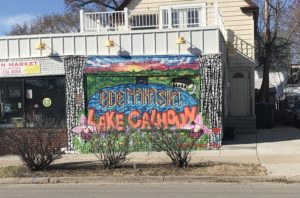 In the 1800s, United States federal surveyors renamed the lake “Calhoun” after John C. Calhoun who was, at that time, secretary of war. Born in South Carolina, the long-time politician likely never set foot in Minnesota. Calhoun, who died in 1850, was pro-slavery professional racist dude. After his stint as secretary of war he became Vice President, first under John Quincy Adams and then to Andrew Jackson (Source). Calhoun was an ardent supporter of the Indian Removal Act which led to the displacement of Cherokee people known as the “Trail of Tears”
In the 1800s, United States federal surveyors renamed the lake “Calhoun” after John C. Calhoun who was, at that time, secretary of war. Born in South Carolina, the long-time politician likely never set foot in Minnesota. Calhoun, who died in 1850, was pro-slavery professional racist dude. After his stint as secretary of war he became Vice President, first under John Quincy Adams and then to Andrew Jackson (Source). Calhoun was an ardent supporter of the Indian Removal Act which led to the displacement of Cherokee people known as the “Trail of Tears”
Not many people in Minneapolis think that Calhoun was a good dude. However, the activism to restore the native name quickly met with protests. For people who opposed the change, Calhoun didn’t represent a dead white dude; it was what the lake had been called for the past 150 years and should remain as such. Many folks against returning the lake to its indigenous name also claimed the change would cause difficulties for local businesses and that Bde Maka Ska was hard to pronounce (handy video here). The anti-restoration people – led by a Venture Capitalist named Tom Austin – created the group “Save Lake Calhoun,” whose purpose was to keep the name exactly as it was.
The Long Road to Change
In 2015, signs around the lake were changed to include both names, stacked on top of each other.
In 2018, the Minnesota DNR, with support from the Minneapolis Parks Board, officially changed the name of the lake from Lake Calhoun to Bde Maka Ska. Signs all around the large lake were changed once again to signal the lake’s one true name. The US Board on Geographic Names updated the lake’s name that year (Source).
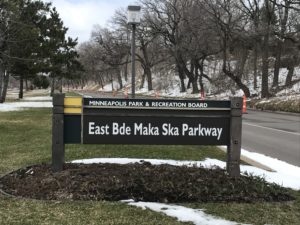 In 2019, the two roads framing the lake were renamed East Bde Maka Ska Parkway and West Bde Maka Ska. The renaming affected more than three-hundred addresses, annoying many residents as they changed their personal identification information like licenses and credit cards (Source).
In 2019, the two roads framing the lake were renamed East Bde Maka Ska Parkway and West Bde Maka Ska. The renaming affected more than three-hundred addresses, annoying many residents as they changed their personal identification information like licenses and credit cards (Source).
No one was more annoyed than the group Save Lake Calhoun, who sued the DNR under the claim that changing the name of the lake was illegal. Apparently, Minnesota has a law that “limits the ability of local officials to change a body of water’s name when it has stood for 40 or more years” (Source). The case went to the MN Supreme Court in late 2019. Lawyers for the DNR argued that Minnesota gave the DNR the power to change the names of lakes when they are offensive, which Calhoun…was. It doesn’t look like a decision has been made on the case, but, by the look of their website, Save Lake Calhoun is no longer an active organization.
Bde Maka Ska is likely here to stay and, with support from the local government, has the appropriate signage. The wealthy neighborhoods surrounding the lake are in no rush to match their efforts. East Calhoun Neighborhood changed their name to ECCO, their former acronym, in early 2020 through online and postal voting (Source). West Calhoun Neighborhood did a similar survey but has no apparent path or interest in change (Source).
Language and Legacy
I have to admit something; before I started doing this research a couple weeks ago, I was pronouncing Bde Maka Ska wrong (saying MAH-kah instead of mah-KAH). Over the course of this research, my standing never changed – restoring the name of the lake was the right thing to do – but my superiority for being on the “right” side was challenged. Name restoration requires both learning and unlearning for everyone involved. It requires a hundred miniscule changes and, often, a hundred fights along the way.
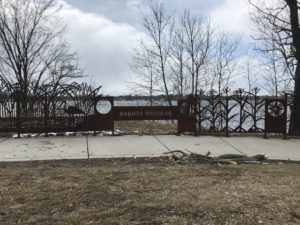 When my housemates and I went to worship at the Minneapolis Friends Meeting we would drive past a public art installation at the edge of the water. The metal installation isn’t near the beach, where visitors find instead the obligatory giant beach chairs (is this a Midwest thing? I don’t know.) Instead, the art sits where the village Ȟeyáta Othúŋwe is thought to have been. The art and accompanying website were installed in summer 2019 and created by Mona Smith, Sandy Spieler and Angela Two Stars. As soon as funding is granted, there will be additional signs about the history Dakota people at Bde Maka Ska.
When my housemates and I went to worship at the Minneapolis Friends Meeting we would drive past a public art installation at the edge of the water. The metal installation isn’t near the beach, where visitors find instead the obligatory giant beach chairs (is this a Midwest thing? I don’t know.) Instead, the art sits where the village Ȟeyáta Othúŋwe is thought to have been. The art and accompanying website were installed in summer 2019 and created by Mona Smith, Sandy Spieler and Angela Two Stars. As soon as funding is granted, there will be additional signs about the history Dakota people at Bde Maka Ska.
The installation is beautiful, paring Dakota words and phrases with images of corn and cranes. The picture here features the phrase Dakota Wicohan (“Wee-cho-ha”) (in English: “the Dakota Way of Life.”) The art represents everything the lake is – a symbol of heritage, community, and celebration – and what it isn’t anymore.
*Business names have been changed
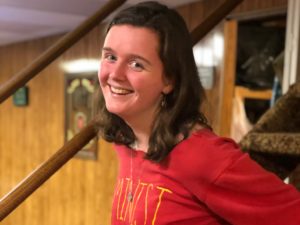 Kirsten Fedorowicz is a recent graduate of Aquinas College in Grand Rapids, Michigan, where she majored in English with a writing emphasis and minored in Women’s Studies. Kirsten was editor-in-chief of the campus newspaper, The Saint, and a writing center consultant. Her passion for social justice was kindled by her work with the Social Action Committee (SAC), a club for which she was Vice President. During her time in college, she studied abroad in a tiny town in Ireland where she lived in a thatched roof cottage and climbed a lot of mountains.
Kirsten Fedorowicz is a recent graduate of Aquinas College in Grand Rapids, Michigan, where she majored in English with a writing emphasis and minored in Women’s Studies. Kirsten was editor-in-chief of the campus newspaper, The Saint, and a writing center consultant. Her passion for social justice was kindled by her work with the Social Action Committee (SAC), a club for which she was Vice President. During her time in college, she studied abroad in a tiny town in Ireland where she lived in a thatched roof cottage and climbed a lot of mountains.
After attending meetings for a short time as a child, Kirsten rediscovered Quakerism her Senior year of college, when she started attending the Grand Rapids Friends meeting. Kirsten is excited to work with Bridging in Minneapolis this year.

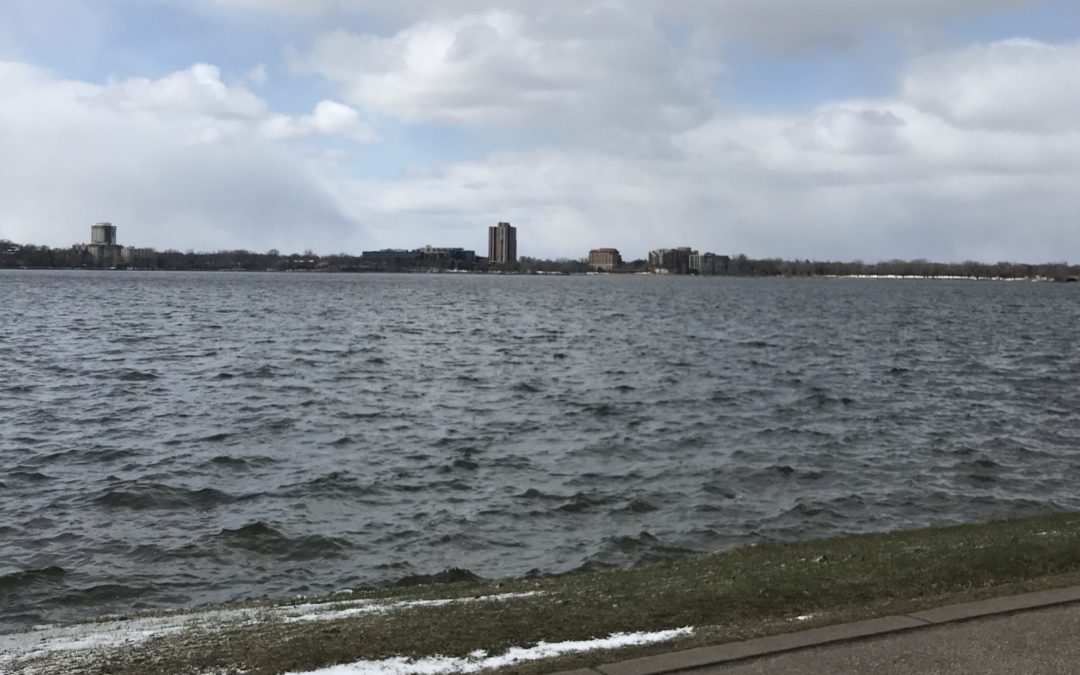
great job on this topic and interesting to hear the local back and forth on the name change. Thank you for this work.
I forget why I went looking at the QVS website but was pleasantly surprised to see your piece here! To answer your question about the status of the name change, your piece was published about a month before the one posted by Healing Minnesota Stories, reporting that the Minnesota State Supreme Court overruled the appellate court and affirmed the name Bde Maka Ska for the lake.
Blessings,
Liz Opp, The Good Raised Up
Thanks Liz! I hadn’t seen that update – thank you for passing it on!
Excellent research, easy to follow. Nice story-telling, with a touch of the usual Dakota humor!
Megwich, Lin B.